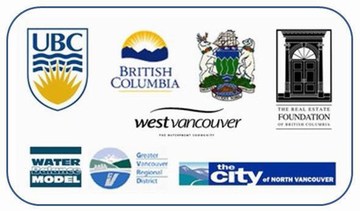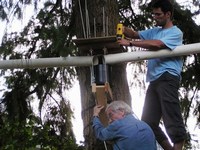Rainfall Interception in an Urban Environment: Results of UBC Tree Canopy Research published

Urban Forest Research Project implemented in Metro Vancouver
During the period 2005 through 2010, the City of North Vancouver, District of West Vancouver, District of North Vancouver, Water Balance Model Inter-Governmental Partnership (IGP), University of British Columbia, Metro Vancouver, Ministry of Community & Rural Development, Real Estate Foundation of British Columbia, and Canada Water Network collaborated to fund and implement the North Shore Tree Canopy Interception Research Project.
The purpose of the Project was to quantify the proportion of rainfall intercepted by the tree canopy in an urban forest. The Project can inform urban planning by providing a science-based understanding regarding the benefits of maintaining a tree canopy in the urban environment.
The City of North Vancouver, District of West Vancouver and District of North Vancouver formed a North Shore Inter-Municipal Coordinating Team (chaired by the District of North Vancouver) to implement a network of 60 tree canopy climate stations across the North Shore.

Overview of Research Program
According to Dr. Markus Weiler, former Chair of Forest Hydrology at UBC, “While considerable research has been undertaken in forest stands in the natural environment, very little has been done in an urban setting anywhere in North America.” Dr. Weiler and Dr. Hans Schreier developed the project approach and the system for rainfall interception. They also recruited a graduate student, Yeganeh Asadian, to undertake the research in fulfillment of her Master’s thesis.
 “We applied a unique methodology for measuring rain/throughfall under 54 different urban trees using a system of PVC pipes hung beneath the canopy to capture the throughfall where it drained into a rain gauge attached to a data logger,” states Yeganeh Asadian.
“We applied a unique methodology for measuring rain/throughfall under 54 different urban trees using a system of PVC pipes hung beneath the canopy to capture the throughfall where it drained into a rain gauge attached to a data logger,” states Yeganeh Asadian.
“To ensure that the study adequately captured the range of throughfall variability, trees were selected to sample different landscape sites (streets, parks, and natural forested areas), elevations, tree type, health condition and species, including Douglas-fir, Western red cedar, Bigleaf maple, Oak, Copper beech, Horse chestnut, Cherry, and Poplar.”
Synopsis of Findings
“Interception loss and throughfall were monitored from February 2007 until November 2008. Rainfall interception varied seasonally for all species. Interception losses accounted for on average 76.5% and 56.4% of gross precipitation for coniferous and deciduous trees, respectively. The interception loss varied depending on canopy structure, climatic conditions, and rainfall characteristics.”
 “The results showed that urban trees intercept and evapotranspire more rain than trees in forested environments. Together with the delay in runoff trees can act as an effective rainwater management tool on individual properties,” concludes Yeganeh Asadian.
“The results showed that urban trees intercept and evapotranspire more rain than trees in forested environments. Together with the delay in runoff trees can act as an effective rainwater management tool on individual properties,” concludes Yeganeh Asadian.
To Learn More:
To download a copy of the Master of Science thesis completed by Yeganeh Asadian at the University of Britsh Columbia, click on Rainfall Interception in an Urban Environment


